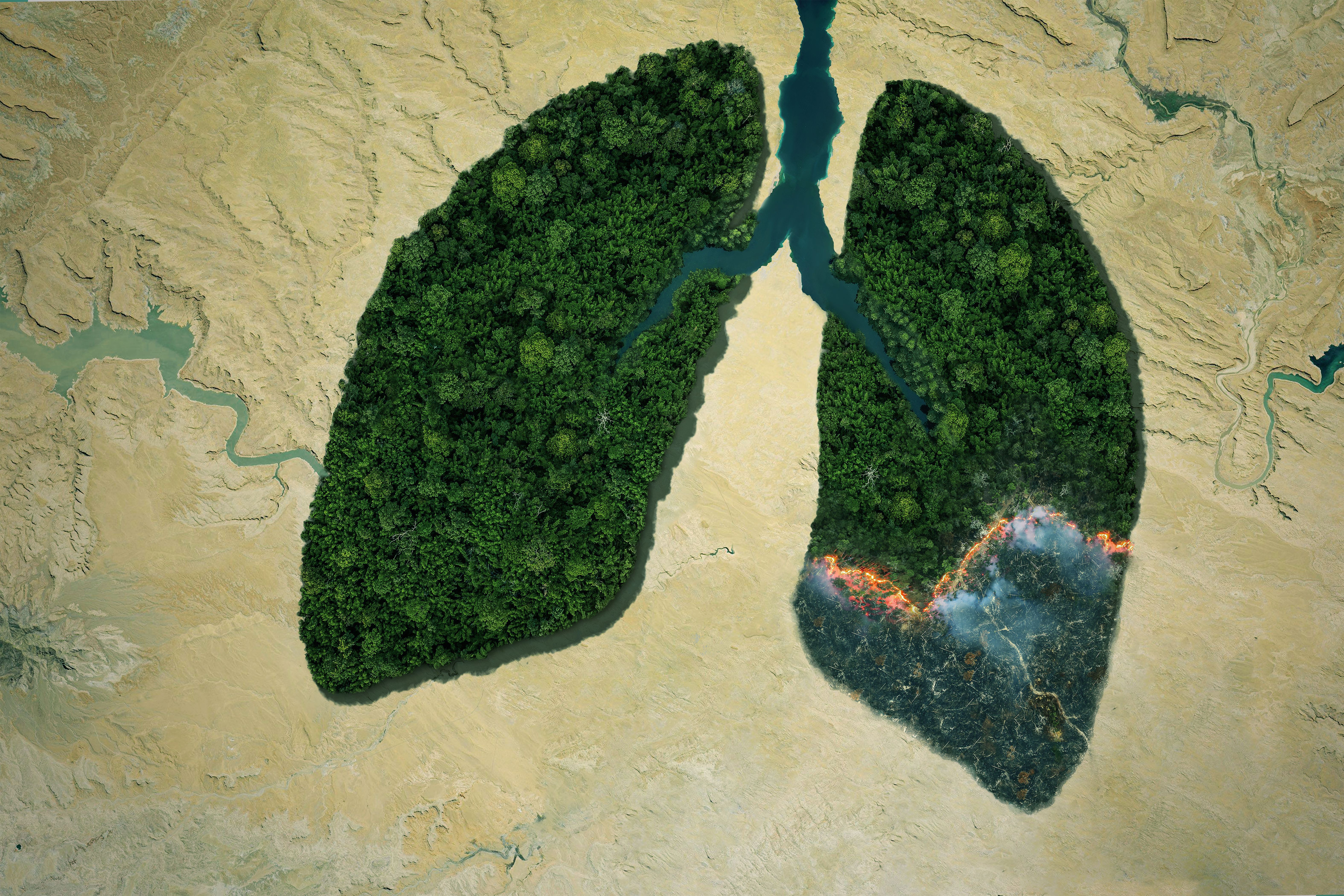- Center on Health Equity & Access
- Clinical
- Health Care Cost
- Health Care Delivery
- Insurance
- Policy
- Technology
- Value-Based Care
A Breathtaking Crisis, Part 1: Climate Change Worsens Asthma
Asthma is worsening under the effects of climate change, such as air pollution and pollen production, especially for underserved populations.
Patients with asthma are experiencing worse asthma symptoms with the effects of climate change.
Image Credit: alones - stock.adobe.com

Asthma is a chronic inflammatory disorder of the airways, often resulting in recurrent attacks of wheezing, breathlessness, chest tightness, coughing, and excess mucus production.1 Experts suggest patients with asthma manage their disorder by avoiding environmental triggers but with the increasing issue of climate change, specifically air pollution, exposure can be difficult to avoid.
Common environmental asthma triggers include pollen allergies either from trees, grasses, hay, or ragweed.2 High pollen count, especially during the spring and fall, are considered major triggers for patients with asthma and are advised to avoid time outside.
Significant changes in the weather, cold air, and humidity are potential triggers for patients with asthma as well. Ultimately, patients with asthma have their own unique triggers but most, if not all, are associated with the environment around them.
On average, asthma is responsible for 5000 deaths and almost 50,000 hospitalizations annually.1 In a National Health and Nutrition Examination Survey from 1999 to 2020, asthma impacts about 8.7% of Americans. Patients who identified as female had greater prevalence (64%) than those who identified as male (36%).3
This marks the first installment of a 2-part series, brought to you by The American Journal of Managed Care® where we explore climate change exacerbations that impact the environmental triggers faced by those with asthma.
Our series, titled “A Breathtaking Crisis, Climate Change Worsens Asthma” will shed light on the effects of climate change over the past few years. The 2-part series kicks off by exploring the environmental triggers patients with asthma endure.2 Mainly, air pollution from motor vehicle traffic, diesel exhausts, ozone smog, nitrogen oxides, and sulfur dioxides are adding to the damage of the Earth’s atmosphere and the lungs of patients with asthma.
In part 2, focus is shifted onto the impacts climate change causes for underserved communities and proposes potential solutions as the effects worsen.
Climate change is amplifying existing environmental triggers for asthma, particularly air pollution and pollen production. This disproportionately harms underserved communities with limited resources who already face higher asthma prevalence.
Impact of Climate Change on Asthma
Asthma, though incurable, can be managed with medication and through the identification of environmental triggers.4 In addition to air pollution factors, higher atmospheric air temperatures and increased frequencies of heat waves are causing socioeconomic burdens and interfere with majority of the population.5
Bronchial asthma is significantly affected by the growing prevalence of pathophysiological impacts on the human body that reflect anthropogenic factors and lifestyle changes.5 The growth patterns of allergen species can often act synergistically with air pollutants and the exposure to high temperature environments, often impacting respiratory mucosal homeostasis.
Climate change has shown signs of exacerbating or causing allergic respiratory diseases by increasing growth rates of plants that are producing more pollen which leads to more allergic proteins contained in pollen, changing the time of the start of plant growth and beginning of pollen season.
With the increased levels of pollen due to climate change, more intense and prolonged periods of pollen have resulted in changes in allergen patterns, increased severity of respiratory tract infections, and altered seasonality of allergies.
Since 2015, the global ambient air temperature over the Earth’s surface has increased at a faster rate compared with the pre-industrial period and over the past 50 years, this is the warmest period on record in history. This issue was recognized by the United Nations Framework Convention on Climate Change who proposed the 2015 Paris Agreement, a commitment of limiting efforts of the global temperature increase to no more than 1.5℃ and reduce global temperature to less than 2℃ above pre-industrial levels by 2050.5
Dhruv S. Kazi, MD, MSc, MS, associate director for the Smith Center for outcomes research in cardiology, commented on this subject in relation to his published study, “Climate Change and Cardiovascular Health: A Systemic Review” of 492 studies from 48 countries that showed the elevated risk of fatal and non-fatal cardiovascular events among older adults and adults with comorbidities, such as prior heart or lung disease.
“Our environment affects our health through several different pathways – a direct effect on the body (eg, inhalation of wildfire smoke causing systemic inflammation, which is particularly bad for individuals with asthma), an effect on mental health (eg, increasing rates of stress-related disorders, which increase short- and long-term cardiovascular risk), and damage to the health care or transportation infrastructure (eg, limiting access to emergent procedures)," commented Kazi. "Coupled with the extensive body of literature on the effect of air pollution on heart and lung health, our findings are an urgent call to action for patients and clinicians to engage in conversations about climate change mitigation and adaptation."
In a recent meta-analysis, researchers found strong associations between severe asthma exacerbations and pollen, cypress, and ragweed exposure. Most studies found that increased pollen count has resulted in more patients with asthma being hospitalized. Research linked asthma attacks and emergency admission or hospitalization to an increased grass pollen concentration for a 2-day period in children under 18 years old.6
Additionally, the Environmental Protection Agency (EPA) released a report in April 2023 showcasing examples on how children are especially vulnerable to the health effects of climate change for various reasons.7
Michael S. Regan, EPA administrator, commented on the report, “Understanding health risks to children is critical in developing effective and equitable strategies that will protect our current and future generations.”7
In addition to air pollution factors, higher atmospheric air temperatures and increased frequencies of heat waves are causing socioeconomic burdens and interfere with majority of the population.
Image Credit: Antonio Rodriguez - stock.adobe.com

Climate Change Overtime
Ambient air temperatures and atmospheric carbon dioxide (CO2) concentrations are among the 2 main environmental parameters that are expected to continue to impact the near future with local, regional, and global climate change.5
With the increasing popularity of urban industrialization, the effects of climate change are expected to increase in severity. Over recent years, CO2 concentrations increased by 30% over a 24-hour duration.5 Consequently, the rise in CO2 concentrations leads to increases in pollen production.
Research has pointed to higher ambient temperatures with increased concentrations of atmospheric CO2 projected to increase for the entire planet, affecting plant biology and physiology by providing more carbon for photosynthesis, biomass production, and increased CO2 fertilization. These outcomes impact the spread of invasive plants, the onset or duration and intensity of pollination, allergen content and allergenicity, as well as biological aerosol particles.5
Urban areas that are already expected to have an increase in CO2 concentration are predicted to also have an increase in ragweed growth, earlier and more intense flowers, as well as increased pollen production compared with rural areas where pollen production and CO2 concentration is lower.5
Recently, links were found between climate change and increased humidity, heavy rainfall, and increased proliferation of aeroallergenic plants. In addition, patients with asthma had increased exacerbations of asthma attacks and hospitalizations following storms.5
A systemic review and meta-analysis found associations between exposure to extreme weather events and asthma morbidity and mortality, supporting the need to create an asthma action plan so patients can manage their conditions as climate change impacts intensifies.8
Acute exacerbations of bronchial asthma can be caused by extreme climactic events like rain, storms, and wet weather conditions, potentially due to the dispersion of inhalable allergic particles from plant pollen through osmotic breakdown.5 Documented cases of bronchial asthma after rainstorms have spiked within recent years and projections show that they will continue to increase. As weather patterns become more inconsistent, storm-related asthma symptoms are likely to increase due to the rise in allergic proteins in the air and high humidity.
On November 21, 2016, the largest reported epidemic thunderstorm asthma event occurred in Melbourne, Australia.9 Emergency rooms were flooded with thousands of patients who presented asthmatic respiratory symptoms and there were a total of 10 untimely deaths caused by the storm.10
Future impacts of climate change on asthma are a threat to various populations. Episodes of thunderstorm asthma have become more frequent as climate change worsens.9 As severe levels of air pollution increase, so does the development of pollen-related allergies, resulting in more outbreaks of thunderstorm asthma.
In the EPA’s report, it estimated elements of climate change, specifically reductions in air quality, will increase asthma incidence in adolescents, predicting that increases in oak, birch, and grass pollen will surge asthma related emergency department visits by 17% to 30% annually.7
The frequency and severity of storms will increase based on near-surface air warming effects along with changes to growth patterns of allergen producing plants and triggering pollens. Climate change events are interlinked with one another. As atmospheric CO2 levels rise, the risk of extreme storms with asthma inducing events does too. The geography of these storms will vary because climate change is more likely to affect regions outside of usual seasons and previously unaffected areas.
Predicting the outcomes of climate change is difficult because meteorological, aerobiological, and population factors are all moving targets.10 The magnitude of events cannot necessarily be accurately predicted because the data collected is still of newer nature. Therefore, prevention strategies are a valuable choice when managing these effects because of the vast unknown outcomes that may occur.
In a statement, Elizabeth Bechard, senior policy analyst for the Moms Clean Air Force, commented on the EPA’s report, “It offers an important roadmap for policymakers, parents, teachers, health care providers, and childcare workers by highlighting both the challenges we face and potential solutions. For all who care about children’s well-being, EPA’s new report is a call to action — a call we must answer for our children’s sake.”7
References
1. Ethnic disparities in the burden and treatment of asthma. Asthma community network. The National Pharmaceutical Council. January 2005. Accessed June 6, 2024. https://www.asthmacommunitynetwork.org/node/1511
2. Environmental asthma triggers. New York State Department of Health. November 2022. Accessed June 6, 2024. https://health.ny.gov/publications/4955/
3. Swed S, Sawaf B, Al-Obeidat F, et al. Asthma prevalence among United States population insights from NHANES data analysis. Sci Rep. 2024;14(1):8059. April 5, 2024. Accessed June 20, 2024. doi:10.1038/s41598-024-58429-5
4. Motavvef A. 7 reasons why asthma is an environmental justice crisis. WE ACT. May 30, 2017. Accessed June 20, 2024. https://www.weact.org/2017/05/7-reasons-asthma-environmental-justice-crisis/
5. Stoian IM, Pârvu S, Minca DG. Relationship between climate change, air pollution and allergic diseases caused by ambrosia artemisiifolia (common ragweed). Maedica (Bucur). 2024;19(1):94-105. doi:10.26574/maedica.2024.19.1.94
6. Steinzor P. Outdoor pollen exposure may worsen asthma attacks. AJMC. April 3, 2023. Accessed June 24, 2024. https://www.ajmc.com/view/outdoor-pollen-exposure-may-worsen-asthma-attacks
7. EPA releases report showing health impacts of climate change on children in the United States. EPA. April 25, 2023. Accessed June 24, 2024. https://www.epa.gov/newsreleases/epa-releases-report-showing-health-impacts-climate-change-children-united-states#:~:text=Climate%20change%20is%20expected%20to
8. Steinzor P. Asthma morbidity, mortality linked to extreme weather events, study finds. AJMC. June 16, 2023. Accessed June 24, 2024. https://www.ajmc.com/view/asthma-morbidity-mortality-linked-to-extreme-weather-events-study-finds
9. Kevat A. Thunderstorm asthma: Looking back and looking forward. J Asthma Allergy. 2020;13:293-299. doi:10.2147/JAA.S265697
10. Price D, Hughes KM, Dona DW, et al. The perfect storm: Temporal analysis of air during the world’s most deadly epidemic thunderstorm asthma (ETSA) event in Melbourne. Ther Adv. 2023;17. doi:10.1177/17534666231186726
Trends in Hospital Pricing for Vulnerable Emergency Department Users, 2021-2023
December 4th 2025Self-pay emergency department prices rose significantly from 2021 to 2023, especially at for-profit and system-affiliated hospitals, highlighting growing affordability challenges for uninsured and underinsured patients.
Read More
